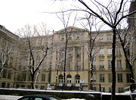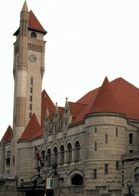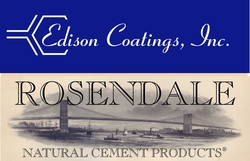Edison Coatings has custom-matched and manufactured historic cement-lime repointing mortars for the US Supreme Court Building
 Repointing of this historic school building in Montreal was performed using several Spec Joint 46 Type O formulations. Repointing of this historic school building in Montreal was performed using several Spec Joint 46 Type O formulations.
PORTLAND CEMENT has been the predominant hydraulic binder used in both North America and Europe since 1900. It is relatively inexpensive, relatively strong and develops its strength relatively quickly. It is not uncommon for portland cement-based mortars to develop full strength in 7-10 days at moderate temperatures, though most standards still specify performance requirements at 28 days.
Portland Cement is considered to be too hard and too rigid for use as a stand-alone binder in masonry mortars, though that was not universally known in the early 20th Century. To moderate its properties, it is necessary to add softer materials to the cement, and typically either hydrated lime or crushed limestone powders are used. |
MASONRY CEMENT VS. CEMENT/LIME
Masonry Cements and Mortar Cements are proprietary mixtures, generally combining portland or blended cements and crushed limestone with a series of additives to enhance workability. For most historic restoration work, however, it is common to exclude these unknown compositions and restrict the mortar binder to blends of portland cement and hydrated lime. NON-STAINING CEMENT Mortars used with limestone and marble must also be low in soluble alkali to avoid the potential creation of stains in the repointed stone. Generally, white portland cement meets this requirement. TYPES M, S, N, O & K Cement/Lime Mortars can be specified either by the proportions of their ingredients or by the minimum strength they are required to achieve at 28 days. For cement/lime mortars, higher strengths are achieved by increasing the proportion of cement and lower strengths are achieved by increasing the proportion of lime. Sand proportions are required to be within set limits, and neither oversanding nor undersanding are acceptable alternatives for adjusting strength. ASTM C270 Standard Specification for Mortar for Unit Masonry designates four basic types of mortar and one optional tuckpointing mortar. From the hardest to the softest, they are designated at Types M, S, N, O and K. These are the alternating letters in the words "MASON WORK". |
SPECIFYING MORTAR PROPORTIONS
Most restoration specifications will indirectly attempt to provide mortar of compatible strength with the original mortar by specifying mix proportions. A guiding principle in historic repointing is that repointing mortar should be of the same strength or softer than the original mortar. While this seems simple in theory, it is more complicated in practice. There is no reliable way to measure the strength of existing mortar. The most common approach to specifying historically accurate repointing mixes is to analyze the existing mortar, determine the original proportions and replicate the mixture. This is a reasonable way to approach repairs and maintenance of relatively modern buildings, but may not be the best way to address the needs of late 19th Century and earlier 20th Century buildings. In particular, buildings built with portland cement-based mortars prior to the 1930's or so were using cements that were much lower in strength than the cements produced today. A 1925 portland cement, for example, might develop as little as 50% or less of the strength of the cement we find available today. It should also be recognized that mortars used for repointing are generally mixed with less water than mortars used for bricklaying, and this results in higher strength as well. A good general rule, then, should be to use repointing mortar one grade softer than the original mortar. |
HISTORY OF USE
Though portland cement was patented in England in 1824, it is primarily a 20th Century material. Very little 19th Century cement was actually processed at high enough temperature to form true portland cements. No portland cement was imported to the United States before 1868, and none was produced here until 1872. Volumes of use were relatively small until the 1890's, when technical advances in processing made it possible to reduce cost, and a turn towards concrete construction increased demand for stronger, faster-curing portland cement. |
 St. Louis Union Station was repointed using Spec Joint 46 Type N in a custom-matched formulation. St. Louis Union Station was repointed using Spec Joint 46 Type N in a custom-matched formulation.
AVAILABLE PRODUCTS
Spec Joint 46 prepackaged mortars are offered in Types M, S, N, O or K. They may be specified either by proportion or by performance. They are typically formulated to assure development of moderate strengths, to assure that historic masonry is not distressed by mortar that is too hard, rigid or dense. |

